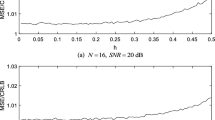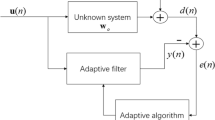Abstract
This paper presents a method for blind separation and DOA estimation of narrow-band independent signals based on eigenvalue decomposition. It can effectively improve the blind separation performance of array mixed signals under the condition of low signal-to-noise ratio. At the same time, the DOA of the separated signal is estimated. It is of great significance to improve the adaptability of array system in complex electromagnetic signal environment.








Similar content being viewed by others
References
Cardoso, J.F.: Blind beamforming for non-gaussian signals. IEE Proc.-F 140(6), 362–370 (1993)
Bingham, E., Hyvarinen, A.: A fast fixed-point algorithm for independent component analysis of complex valued signals. Int. J. Neural Syst. 10(1), 1–8 (2000)
Fu, Wh, Yang, X.N., Liu, N.A., Zeng, X.W.: Communication signal blind reconnaissance technology based on independent component analysis. J. Sichuan Univ. 44(6), 1245–1249 (2007)
Xiang, Y., Cheng, W.D., Xie, J.A.: Blind source separation algorithm based on ULA. Radio Eng. 42(4), 15–18 (2012)
Sawada, H., Mukai, R., Makino, S.: Direction of arrival estimation for multiple source signals using independent component analysis. In: Proceedings of international symposium on signal processing and its applications, July 2003, 2, pp. 411–414
Xiao, W.S., Zhang, X.G., Du, S.D.: Blind separation of radar signals. J. Nanjing Univ. 42(1), 38–43 (2006)
Zhao, J., Yang, J.S., Jin, J.B.: DOA estimation based on JADE algorithm. J. Commun. 31(8), 91–97 (2010)
Caddo, J.A., Kim, Y.S., Shine, D.C.: General direction-of-arrival estimation: a signal subspace approach. IEEE Trans. AES 25(1), 31–46 (1989)
Ma, C.W., Tang, C.: Detection of coherent signals using weighted subspace smoothing. IEEE Trans. AP 44(2), 179–187 (1996)
Liu, Z.M., Huang, Z.T., Zhou, Y.Y.: Direction-of-arrival estimation of wideband signals via covariance matrix sparse representation. IEEE Trans. Signal Process. 59(9), 4256–4270 (2011)
Liu, Z.M., Huang, Z.T., Zhou, Y.Y.: An efficient maximum likelihood method for direction-of-arrival estimation via sparse Bayesian learning. IEEE Trans. Wirel. Commun. 11(10), 3607–3617 (2012)
Malioutov, D., Çetin, M., Willsky, A.S.: A sparse signal reconstruction perspective for source localization with sensor arrays. IEEE Trans. Signal Process. 53(8), 3010–3022 (2005)
Zhang, Y., Ye, Z., Xu, X., et al.: Off-grid DOA estimation using array covariance matrix and block-sparse Bayesian learning. Signal Process. 98, 197–201 (2014)
Liu-Li, Wu, Liu, Zhang-Meng, Jiang, Wen-Li: A direction finding method for spatial optical beam-forming network based on sparse Bayesian learning. Signal Image Video Process. 11(2), 203–209 (2017)
Deng, B., Tao, R., Yin, D.Q.: Blind source separation of the array signal in the fractional fourier Domain. Acta Armamentarii 30(11), 1451–1456 (2009)
Zhang, A.Q., Qiu, T.S.: Blind signals separation in array beam space. Syst. Eng. Electron. 30(9), 1629–1631 (2008)
Author information
Authors and Affiliations
Corresponding author
Additional information
Publisher's Note
Springer Nature remains neutral with regard to jurisdictional claims in published maps and institutional affiliations.
Rights and permissions
About this article
Cite this article
Xiong, Kl., Yang, A. Blind array signal separation and DOA estimation method based on eigenvalue decomposition. SIViP 15, 1107–1113 (2021). https://doi.org/10.1007/s11760-020-01837-7
Received:
Revised:
Accepted:
Published:
Issue Date:
DOI: https://doi.org/10.1007/s11760-020-01837-7




